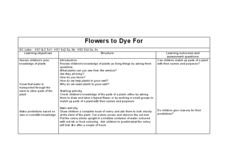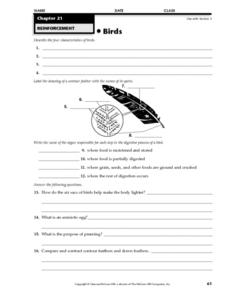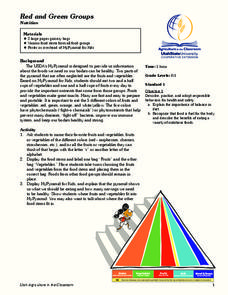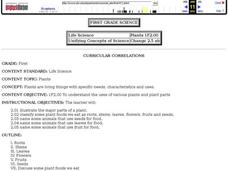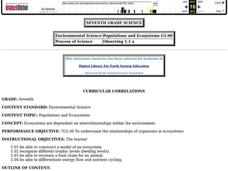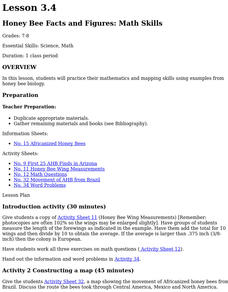Curated OER
Rethink Your Drink
Students examine the sugar content of common beverages. In this adult health lesson, students convert grams of sugar to teaspoons. They discuss the benefits of drinking water instead of soda and juices.
Curated OER
Flowers to Dye For
Learners observe biology by completing a plant experiment in class. In this botany instructional activity, students discuss the anatomy related to a plant and how roots and stems are necessary to its survival. Learners utilize food...
Curated OER
Hazardous Products Substitutes
Students investigate toxic substances. In this health lesson, students identify warning labels on common household cleaners and create a "less toxic" cleaning recipe book. Students recite a pledge to try a less toxic substitute at home.
Curated OER
Observing Pods
Students observe the pistil growing into a tiny string bean-like seed pod. They then observe the development of the fertilized pods between Day 17 and Day 35 and record their observations by drawing and labeling, writing, and graphing. ...
Curated OER
A Well Balanced Meal
Students are given paper plates and pictures of food. They are to glue the foods they would eat that would make a balanced meal.
Curated OER
An Ancient Greek and Roman Festival
Third graders label a map of ancient Greek and Roman civilizations and do a written report on one element of these two cultures. They participate in discussions of food, farming, daily life and government (among others). Students use the...
Curated OER
A Helthy Diet
Students examine their eating habits and experience analyzing data and drawing conclusions. They construct models of the molecular backbone of saturated and unsaturated fats. In addition, they examine the labels of their food, record...
Curated OER
Bird Activity
For this bird worksheet, students complete a set of 16 activities about birds, listing characteristics, matching organs with steps in the digestive process, labeling a drawing of a feather and completing 4 short answer questions.
Curated OER
Behold the Mold!
Students explore how mold grows on various food items. In this mold lesson plan, students predict how mold will grow on dry vs. wet food items, and chart their observations daily. Children develop a summary to aid them in a summative...
Curated OER
Showing Nature's Way-Plant Development and the Plant Parts We Eat
Students explore plant life. For this science lesson plan, students demonstrate and record the stages of plant growth and categorize food plants by identifying the edible part.
Curated OER
Comparing Seeds
Students explore the process of growing plants from seeds. In this hands-on science experiment, students observe different seeds (store bought vs. those directly from food items) and predict growing patterns.
Curated OER
Red and Green Groups
Students select fruits and vegetables from a group of items placed in a bag. In this food pyramids lesson, students focus on the fruits and vegetables. Students understand the need to eat foods and vegetables.
Curated OER
Software Lesson Plan for FoodWorks
Students complete analysis of foods consumed in three days by using FoodWorks software program, identify factors that influence food intake, examine factors that influence their own eating behaviors, evaluate their current eating habits,...
Curated OER
Plants
Students illustrate the major parts of a plant, classify some plant foods we eat as roots, stems, leaves, flowers, fruits and seeds. They also name some animals that use seeds, leaves, and fruit for food.
Curated OER
Starvation in the Ghettos
Students investigate how human beings survive under camp and ghetto life's extreme condition while understanding the USRDA requirements. They recognize the suffering and loss of life due to the lack of adequate nutrition.
Curated OER
Populations and Ecosystems
Seventh graders create a model of an ecosystem and label it to show structure and function. They research the food web of an aquatic animal and also trace energy flow from the primary producer up the food chain.
Curated OER
Science Processes
Fifth graders observe a dry piece of bread and a damp piece of bread in two separate sealed bags that have been sitting for several days that have been labeled. The observe the mold with a hand lens and record findings in their science...
Curated OER
Diet: Find the Carbohydrates
Students discover and discuss the functions of carbohydrates. Once they have taken notes and completed worksheets, they perform experiments using iodine to test for starch. Lesson topics include how carbohydrates are processed by the...
Curated OER
Homogenous and Heterogeneous Mixtures
Fourth graders explain and describe what a mixture is, distinguish between the two types of mixtures (which are heterogeneous vs.homogenous) and are able to create and appropriately label mixtures.
Curated OER
Ocean Currents
Students label the names, relative temperature, distribution, and direction of flow of major ocean currents on a world map. They also explore and model the natural forces that affect the movement of ocean currents through demonstrations...
Curated OER
The Science of Glaciers
Students identify the contents of a glacier like those found in Patagonia. They construct a mini glacier model in class. Students compare and contrast the classroom model with Patagonian glaciers. They label specific parts of the...
Curated OER
Energy in Living Systems
Students are asked: Is our life's purpose over when it's over? What happens to our bodies? They analyze the flow of energy through living systems. Students compare the metabolism of autotrophs with that of heterotrophs. They create a...
Curated OER
Your Digestive System
In this digestive system worksheet, 9th graders describe the function of each organ listed that aid in the digestion of food. Then they label each organ on the diagram given at the bottom of the sheet.
Curated OER
Honey Bee Facts And Figures: Math Skills
Learners practice their mathematics and mapping skills using examples from honey bee biology. Discuss why the colonies were found in this pattern. They examine food and water in the area, and how many humans live in the area where...

